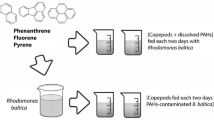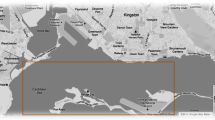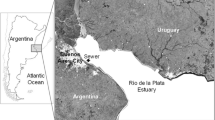Abstract
Polychlorinated biphenyls (PCBs) were measured in six compartments of the sea bass (Dicentrarchus labrax) food web from the Seine estuary. Similar PCB patterns were observed in all samples. The main components possess the −245, 234, −2345 chlorine substitution Contamination increases with the trophic level. The highest concentrations were found in sea bass amounting 300 ng g−1 (d.w.) in the oldest individuals. A six-compartment steady-state food web model is proposed for the food web leading to the sea bass. Several exposure pathways are considered in the description of the accumulation by animals: the ingestion of particulate contaminants associated with either phytoplankton and detritus, and the respiratory uptake of truly dissolved contaminants in the overlaying, water. The application of this model indicates that feeding is the principal route of contamination, especially for PCBs which have more than four chlorine atoms and that feeding preference, phytoplankton lipid fraction, and organic carbon, content of detritus are parameters which mostly determine the bioaccumulation in this food web.
Similar content being viewed by others
Literature Cited
Aaser, H. F., E. Jeppesen, andM. Sondergaard. 1995. Seasonal dynamics of the mysidNeomysis integer and its predation on the copepodEurytemora affinis in a shallow hypertrophic brackish lake.Marine Ecology Progress Series 127:47–56.
Abarnou, A. andS. Simon. 1986. Contamination de l’estuaire et de la baie de Seine par les PCB, p. 471–476.In Institut Français de Recherche pour l’Exploitation de la Mer, (eds.), Colloque Baie de Seine. Actes de Colloques No. 4. IFREMER, France.
Aguilar, A. 1987. Using organochlorine pollutants to discriminate marine mammal populations: A review and critique of the methods.Marine Mammal Science 33:242–262.
Avoine, J. 1986. Sediment exchanges between the Seine estuary and its adjacent shelf.Journal of the Geological Society 143:1–14.
Ballestrazzi, R. andD. Lanari. 1996. Growth, body composition and nutrient retention efficiency of growing sea bass (Dicentrarchus labrax L.) fed with fish oil or fatty acid Ca salts.Aquaculture 139:99–107.
Balischmiter, K. andM. Zell. 1980. Analysis of PCB by glass capillary gas chromatography.Fresenius Zeitschrift für Analytische Chemie 302:20–31.
Barber, C. M., L. A. Suarez, andR. R. Lassister. 1988. Modelling bioconcentration of nonpolar organic pollutants by fish.Environmental Toxicology and Chemistry 7:545–558.
Baron, M. G. 1990. Bioconcentration.Environmental Science and Technology 24:1612–1618.
Bertignac, M. 1987. L’exploitation du bar. Thèse de 3 eme cycle. ENSA de Rennes, France.
Bessineton, C. and S. Simon. 1996. Etude des populations de poissons et des réseaux trophiques. Rapport 1995/Fin-4. Rapport d’activité du Programme Scientifique Seine-Aval, Rouen, France.
Bessineton, C. and S. Simon. 1997. Recensement des poissons et analyse des régimes alimentaires du barDicentrachus labrax et du fletPlatichthys flesus en estuaire de Seine. Rapport 1996/Fin-4. Rapport d’activité du Programme Scientifique Seine-Aval, Rouen, France.
Boon, J., F. Eijgenraam, J. Everaats, andJ. C. Duinker 1989. A structure-activity relationship (SAR) approach towards metabolism of PCBs in marine animals from different trophic levels.Marine Environmental Research 27:159–176.
Boon, J., R. C. Oudejans, andJ. C. Duinker. 1984. Kinetics of individual polychlorinated biphenyl (PCB) components in juvenile sole (Solea solea) in relation to their concentrations in food and to lipid metabolism.Comparative Biochemistry and Physiology 79:131–142.
Boon, J., E. Van Arnhen, S. Jansen, N. Kannan, G. Petrick, D. Schulz, J. C. Duinker, P. Reijnkers, andA. Gosoyr. 1990. The toxicokinetics of PCBs in marine mammals with special reference to possible interactions of individual congeners with the cytochrome P450-dependent mono-oxygenases system. An overview, p. 119–159.In C. H. Walker and D. R. Livingstone (eds.), Persistent Pollutants in Marine Ecosystems. Pergamon Press, Oxford.
Bowadt, S. andB. Larsen. 1992. Improved congener-specific GC analysis of chlorobiphenyls on coupled CPSil 8 and HT5 columns.Journal of High Resolution Chromatography 15:377–380.
Brown, P., J. McLaughin, L. O’Connor, andK. Wyman. 1982. A mathematical model of PCB bioaccumulation in plankton.Ecological Modelling 15:159–176.
Campfens, J. andD. Mackay. 1997. Fugacity based model of PCB bioaccumulation in complex aquatic foodwebs.Environmental Science and Technology 31:577–583.
Claisse, D. 1989. Chemical contamination of French coast: The results of ten years mussel watch.Marine Pollution Bulletin 20: 523–528.
Clark, E., F. A. Gobas, andD. Mackay. 1990. Model of organic chemical uptake and clearance by fish from food and water.Environmental Science and Technology 24:1203–1213.
Connolly, J. P. 1991. Application of a food chain model to polychlorinated biphenyl contamination of the lobster and winter flounder food chains in New Bedford harbor.Environmental Science and Technology 25:760–770.
de Boer, J., Q. T. Dao, andR. Van Dortmond. 1992. Retention times of fifty one chlorobiphenyl congeners on seven narrow bore capillary columns coated with different stationary phase.Journal of High Resolution Chromatography 15:249–255.
Del Norte-Campos, A. G. 1995. Ecological studies on the coexistence of the brown shrimp,Crangon crangon L. and the gobiesPomatoschistus microps Kroyer andP. minutus Pallas in shallow areas of the German Wadden Sea. Ph.D. Thesis, University of Hamburg, Germany.
Duinker, J. C., D. E. Schulz, andG. Petrick. 1988. Multidimensional gas chromatography with electron capture detection for the determination of toxic congeners in polychlorinated biphenyl mixtures.Analytical Chemistry 60:478–482.
Durbin, E. G. andA. G. Durbin. 1978. Length and weight relationships ofAcartia clausii from Narragansett Bay, RI.Limnology and Oceanography 23:958–969.
Founda, M. M. andP. J. Miller. 1981. Age and growth of the common gobyPomatoschistus microps, on the south coast England.Estuarine Coastal and Shelf Sciences 12:121–129.
Fourqurean, J. W., K. L. Webb, J. T. Hollibaugh, andS. V. Smith. 1997. Contributions of the plankton community to ecosystem respiration, Tomales Bay, California.Estuarine Coastal and Shelf Sciences 44:493–505.
Garnier, J., G. Billen, T. Berthe, X. Philippon, and C. Valéry. 1996. Etude du cycle de l’azote dans l’estuaire de la Seine: Nitrification, dénitrification et production de N2O. Rapport 1996/Fin-2. Rapport d’activité du Programme Scientifique Seine-Aval, Rouen, France.
Goerke, H. andW. Ernst. 1971. Fate of14C labelled di-, tri-, and pentachlorobiphenyl in the marine annelid (Nereis virens). I Accumulation and elimination after oral administration.Chemosphere 6:551–558.
Guezennec, L., R. Lafite, J.-P. Dupont, R. Meyer, andD. Boust. 1999. Hydrodynamics of suspended particulate matter in the tidal freshwater zone of a macrotidal estuary (the Seine estuary, France).Estuaries 22:717–727.
Gutenmann, W. H., J. G. Ebel, Jr.,H. T. Kuntz, K. S. Yourstone, andD. J. Lisk. 1992. Residues of pp’DDE and mercury in lake trout as a function of age.Archives of Environmental Toxicology 22:452–455.
Hansen, P. J., P. K. Bjornsen, andB. W. Hansen. 1995. Zooplankton grazing and growth: Scaling within the 2–2,000-μm body size range.Limnology and Oceanography 42:687–704.
Harding, G. C. 1986. Organochlorine dynamics between zooplankton and their environment, a reassessment.Marine Ecology 33:167–191.
Harding, G. C., R. J. Leblanc, W. P. Vass, R. F. Addison, B. T. Hargrave, S. Peare, Jr.,A. Dupuis, andP. F., Brodie. 1997. Bioaccumulation of polychlorinated biphenyls (PCBs) in the marine pelagic food web, based on a seasonal study in the southern Gulf of St. Lawrence, 1976–1977.Marine Chemistry 56:145–179.
Hawker, D. W. andD. W. Connell. 1988. Octanol-water partition coefficients of polychlorinated biphenyl congeners.Environmental Science and Technology 22:382–387.
Huson, L. W. 1982. A graphical aid to multivariate sensitivity analysis.Ecological Modelling 16:91–98.
Irvine, K., D. Snook, andB. Moss. 1995. Life history ofNeomysis integer, and its copepod prey,Eurytemora affinis, in a eutrophic and brackish shallow lake.Hydrobiologia 304:59–76.
Kamman, U., R. Knickmeyer andH. Steinhart. 1990. Distribution of PCBs and HCB in different tissues of the dab (Limanda limanda L.) in relation to lipid polarity.Bulletin Environmental Contamination and Toxicology 45:552–559.
Kannan, N., T. B. H. Reush, D. E. Schulz-Bull, G. Petrick, andJ. C. Duinker. 1995. Chlorobiphenyls: Model compounds for metabolism in food chain organisms and their potential use as ecotoxicological stress indicators by application of the metabolism slope concept.Environmental Science and Technology 29:1851–1859.
Knickmeyer, R. andH. Steinhardt 1989. On the distribution of PCB congeners and HCB in different tissues of dab (Limanda limanda) from the North Sea.Chemosphere 19:1309–1320.
Law, R., C. R. Allchin, andR. J. Morris. 1995. Uptake of organochlorines (chorobiphenyls, dieldrin total PCB and DDT) in bottlenose dolphins (Tursiops truncatus) from Cardigan bay, west Wales.Chemosphere 3:547–560.
Lemaire, P. 1990. Caractérisation et induction des enzymes de biotransformation chez un poisson marin, le loup, (Dicentrarchus labrax). These de doctorat de l’Universite Paris 6, Spécialité Océanologie Biologie, France.
Lemaire, P., E. Gasset, D. Cam, andE. de la Fonchais. 1992. Model of oxygen consumption for sea bassDicentrarchus labrax and sea breamSparus auratus.Ichtyophysiology Acta 15:55–68.
Loizeau, V. 1992. Distribution des PCB dans la limande et les espèces benthiques de la baie de Seine.Journal de la Recherche Océanographique 17:61–67.
Loizeau, V. andA. Abarnou. 1994. Distribution of polychlorinated biphenyls in dab (Limanda limanda) from the baie de Seine (Eastern Channel).Marine Environmental Research 38: 77–91.
Loizeau, V. and A. Abarnou. 1996. Niveaux de contamination par les PCB dans le réseau trophique du bar et du flet. Programme Scientifique Seine-Aval. Rapport 1995/Fin4, Rouen.
Loizeau, V., A. Abarnou, A. M. Le Guellec, and A. Jaouen. 1997. Bioaccumulation des PCB dans les reseaux trophiques en estuaire de Seine. Rapport d’activité du Programme Scientifique Seine-Aval, 1996/Fin-4, Rouen.
Loizeau, V. andA. Menesguen 1993. A steady-state model of PCB accumulation in dab food web.Oceanologica Acta 16:633–639.
Masski, H. 1998. Caractérisation des frayères et des structures de population de poissons exploités en Manche ouest. Thèse de Doctorat, Université de Bretagne Occidentale, France.
Mayer, I., S. E. Shackley, andP. R. Witthames. 1990. Asepcts of the reproductive biology of the bass,Dicentrarchus labrax L. II. Fecundity and pattern of oocyte development.Journal of Fisheries and Biology 36:141–148.
McKim, S. M., P. Schnieder, andG. Veith. 1985. Adsorption dynamics of organic chemical transport across trout gill as related to octanol water partition coefficient.Toxicology Application of Pharmacology 77:1–10.
Mees, J., Z. Abdulkerim, andO. Hamerlynck. 1994. Life history, growth and production ofNeomysis integer in the Wester Schelde estuary (SW Netherlands).Marine Ecology Progress Series 109: 43–57.
Meixner, R. 1996. On the sex-related size difference of the shrimpCrangon crangon and its impact on the commercial shrimp fishery.Archives of Fischwirtsch 43:6–9.
Mouny, P. and J. C. Dauvin. 1997. Les communautés mesozooplanctoniques et suprabenthiques de l’estuaire de la Seine. 1996/FIN-4. Rapport d’activité du Programme Scientifique Seine-Aval, Rouen.
Muir, D. C. G., R. J. Norstrom, andM. Simon. 1988. Organochlorine contaminants in artic marine food chain: Accumulation of specific polychlorobiphenyls and chlordane related compounds.Environmental Science and Technology 22:1071–1079.
Munschy, C., K. Moisan, and J. Tronczynski. 1996. Inventaire et comportement géochimique de contaminants organiques majeurs dans l’estuaire de la Seine. 1995/FIN-3:2–37. Rapport d’activité du Programme Scientifique Seine-Aval, Rouen, France.
Neely, W. B. 1979. Estimating rate constants for the uptake and clearance of chemicals by fish.Environmental Science and Technology 13:1506–1510.
Nimi, A. J. andB. G. Oliver. 1983. Biological half-life of polychlorinated biphenyls (PCB) congener in whole fish and muscle of rainbown trout (Salmo gairdeni).Canadian Journal of Fisheries and Aquatic Sciences 40:1388–1394.
Oliver, B. G. andA. J. Niimi. 1988. Trophodydamic analysis of polychlorinated biphenyl congeners and other chlorinated hydrocarbons in the lake Ontario ecosystem.Environmental Science and Technology 22:388–397.
Opperhuizen, A. andP. Schrap. 1988. Relationships between octanol/water partition coefficients, aqueous activity coefficients and reversed phase HPLC, capacity factors of alkylbenzenes, chloronaphtalenes and chlorobiphenyls.Toxicology and Environmental Chemistry 15:249–264.
Pastor, D., J. Boix, V. Fernandez, andJ. Albaiges. 1996. Bio-accumulation of organochlorinated contaminants in three estuarine fish species (Mullus barbatus, Mugil cephalus andDicentrarchus labrax).Marine Pollution Bulletin 32:257–262.
Petersen, J. K. andG. I. Petersen. 1990. Tolerance, behaviour and oxygen consumption in the sand goby,Pomatoschistus minutus (Pallas), exposed to hypoxia.Journal of Fish Biology 37: 921–933.
Pickett, M. G. andG. D. Pawson. 1996. The annual pattern of condition and maturity in bass,Dicentrarchus labrax in waters around England and Wales.Journal of the Marine Biological Association of the United Kingdom 76:107–125.
Press, W. H., B. P. Flannery, J. Teukosky, andW. T. Vettering. 1989. Numerical Species. The Art of Scientific Computing (Fortran Version). Cambridge University Press, United Kingdom.
Ramos, J., M. Carrillo, S. Zanuy, and K. Kobayaski. 1982. Growth and food utilization in the sea bass,Dicentrarchus labrax (L.).Informes Tenicos del Instituto de Investigaciones Pesqueras, Bar 94.
Ridgway, S. andM. Reddy. 1995. Residue levels of several organochlorines inTursiops truncatus milk collected at varied stages of lactation.Marine Pollution Bulletin 30:609–614.
Rochard, E., P. Boet, G. Castelnaud, F. Gauthiez, J. F. Bigot, and B. Ballion. 1997. Premier inventaire ichtyologique de la partie basse de la Seine. 1996/Fin-4:8–31. Rapport d’activité du Programme Scientifique Seine-Aval, Rouen, France.
Rybarczyk, H., J. D. Talieux, N. Loquet, E. Loirat, and B. Elkaim. 1997. Analyse comparative des bilans énergétiques et de la composition biochimique des principales espèces des peuplements benthiques de la baie de Seine. 1996/Fin-4:89–104. Repport d’activité du Programme Scientifique Seine-Aval, Rouen, France.
Safe, S. 1984. Polychlorinated biphenyls (PCBs) and polybrominated biphenyls (PBBs): Biochemistry toxicology and mechanism of action.Critical Review of Toxicology 13:319–393.
Salomon, J. C. 1988. Oceanographic characteristics of the Seine estuary, p. 37–47.In B. Kjerfe (ed.), Hydrodynamics of Estuaries II. CRC Press, Boca Raton, Florida.
Schulz-Bull, D. E., G. Petrick, andJ. C. Duinker. 1991. Polychlorinated biphenyls in North Sea water.Marine Chemistry 36: 365–384.
Schweigert, F. J. andW. T. Stobo. 1994. Transfer of fat soluble vitamins and PCBs from mother to pups in grey seals (Halichoerus grypus).Composition Biochemistry and Physiology 2:111–117.
Spacies, A. andJ. L. Hamelink. 1982. Alternative model for describing the bioconcentration of organics in fish.Environmental Toxicology and Chemistry 1:309–320.
Szaniawska, A. andM. Wolowicz. 1984. Seasonal changes of oxygen consumption byCrangon crangon L. (Crustacean, natantia) in the Gulf of gdansk.Oceanologia 19:117–126.
Tanabe, S., K. Maruyaka, andR. Tatsukawa. 1982. Absorption efficiency and biological half-life of individual chlorobiphenyls in carp (Cyprinus carpio) orally exposed to Kanechlor products.Agriculture and Biological Chemistry 46:891–898.
Tanabe, S., H. Tanaka, andR. Tatsukawa. 1984. Polychlorobiphenyls, ΣDDT, and hexachlorocyclohexan isomers in the Western North Pacific ecosystem.Archives of Environmental Contamination and Toxicology 13:731–738.
Taylor, A. C. andJ. L. Spicer. 1987. Interspecific comparison of the respiratory response to declining oxygen tension and the oxygen transporting properties of the blood of some palaemonid prawns (Crustacea: Palaemonidae).Marine Behaviour Physiology 14:81–91.
Thomann, R. V. 1980. Equilibrium model of fate microcontaminants in durne aquatic food chain.Canadian Journal of Fisheries and Aquatic Sciences 38:280–296.
Thomann, R. V. 1989. Bioaccumulation model of organic chemical distribution in aquatic food chains.Environmental Science and Technology 23:689–707.
Thomann, R. V., J. P. Connolly, andT. Parkerton. 1992. An equilibrium model of organic chemical accumulation in aquatic food webs with sediment interaction.Environmental Toxicology and Chemistry 11:615–629.
Vasblom, A. G. andH. B. Elgershuizem. 1997. Survival and oxygen consumption ofPraunus flexuosus andNeomysis integer and embryonic development of the latter species in different temperature and chlorinity combination.netherlands Journal of Sea Research 11:305–315.
Vidal, J. 1980. Physioecology of zooplankton. 1 Effects of phytoplankton concentration, temperature and body size on the growth rate ofCalanus pacificus andPseudocalanus sp.Marine Biology 56:111–134.
Author information
Authors and Affiliations
Corresponding author
Rights and permissions
About this article
Cite this article
Loizeau, V., Abarnou, A. & Ménesguen, A. A steady-state model of PCB bioaccumulation in the sea bass (Dicentrarchus labrax) food web from the Seine estuary, France. Estuaries 24, 1074–1087 (2001). https://doi.org/10.2307/1353019
Received:
Accepted:
Issue Date:
DOI: https://doi.org/10.2307/1353019




